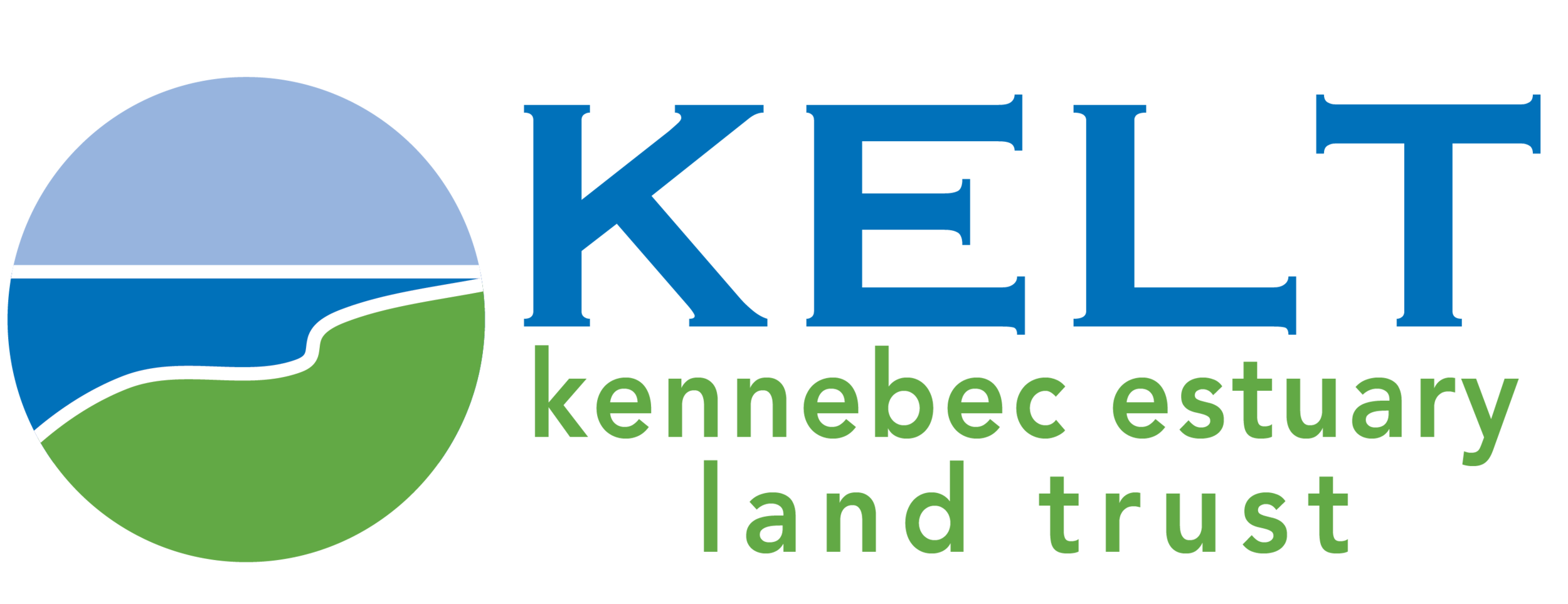In the Field with Helen: Rediscovering Bygone Byways in Morse Pond & Little River Preserves
By Helen Vaughan, Summer Land Steward
I never thought I would be so excited to see a little line on a map indicating an old road on one of KELT’s preserves.
The day before, summer stewards Leila Bannon and I were tromping through KELT’s preserve at Morse Pond with Preserves Manager Dillon Mulhern. We were doing our routine annual inspection, monitoring the preserve for anything unusual like invasive species, encroachments or trash, but struggling to navigate the preserve. We squeezed our way through thickets of brush and trees and tumbled over blowdowns. At some points we would pop out into a corridor of an old road and would aim to follow it, before quickly losing it again. When we finally made our way back to the car, panting and sweaty, covered in bug bites and scratches, Dillon decided it was time to map the old roads across the property.
Helen (left) traverses an old track on Little River marsh preserve.
The next day, Dillon and I had pulled up ArcGIS Pro to see the old roads and ATV tracks on Morse Pond Preserve and the abutting preserve, Little River. We started by collecting historical aerial photographs of the preserve, taken by the Maine Geological Survey. We layered images from the 1960s up to present day, scouring the photos for any old roads and paths. We then used lidar data from the National Oceanic and Atmospheric Administration (NOAA) to see differences in elevation to find what was. Lidar stands for “Light Detection and Ranging,” and according to NOAA, uses a “remote sensing method that uses light in the form of a pulsed laser to measure ranges (variable distances) to Earth.” Lidar allows a relatively precise map of the topography or hills and valleys across the land. Old roads, ATV tracks, and historical embankments show up as distinct lines of different elevation levels across the marsh and through the forest.
I used ArcGIS Pro to map out the lines I saw, when comparing the aerial photographs to lidar data. Flipping back and forth through the pictures and data, I was able to map out the lines and build a story. We had tracked our movements from the following day, and it was clear to see where we popped out on an old road and followed it for a few hundred yards, before losing it again and veering off into the dense brush. It was fascinating to be able to see a clear, broad view of what we had been struggling through so deeply the day before.
The images show Lidar imagery and aerial photography from 1971 of a section of old road in the Morse Pond preserve. The modern day road is grown in but still easier to navigate than thick brush.
Similarly, I was able to map old roads and embankments in the Little River preserve marsh. Before starting at KELT, I never knew that earlier New England settlers used to farm in salt marshes, setting up extensive ditches and embankments to drain certain areas of the marsh or build up soil in other parts, all in the name of better salt hay yields and all for agricultural plantings. Ghosts of these ditches and mounds are still present in our modern day marshes in Maine, impeding historical tidal flow and proper functioning of the marsh. As with Morse Pond, I was able to look through lidar data and historical aerial photographs to see where potential old roads and embankments may have been created across the marsh. A few days later, Dillon, Leila, and I to check out embankments on Little River. The coolest section was an odd semi-circle of raised earth that I had seen on the lidar, which we hypothesized as an old road. In person, it was incredibly clear to see the exact same semi-circle shape in the marsh, by the different species of grasses that lived at higher or lower elevations.
Lidar data and aerial photography from 1971 of an old road or track across the Little River preserve marsh. The mysterious semi-circle shape is still visible today by the different types of grass growing in the last picture.
While we may never know the full story behind these roads, ATV tracks, and marsh embankments, working through ArcGIS Pro gave me an incredible opportunity to see how these tools can be used to best inform management practices. Knowing where these old roads cross through properties is key when navigating a preserve and remediating the problems these old structures may cause.
Dillon stops in a creek to assess our movements through Morse Pond preserve.








